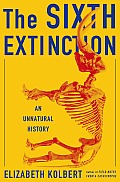 Elizabeth Kolbert’s The Sixth Extinction is both fascinating and frustrating. The title suggests—screams—that there have been five extinctions at some time or another and that she’s going to describe them, then tell us about that number six. It’s not quite that orderly.
Elizabeth Kolbert’s The Sixth Extinction is both fascinating and frustrating. The title suggests—screams—that there have been five extinctions at some time or another and that she’s going to describe them, then tell us about that number six. It’s not quite that orderly.
The “extinctions of course refer to the elimination of species from life on the planet. There are reasons why Kolbert doesn’t conveniently list the big five. For one thing, the very idea of extinction was as big a controversy as the idea of evolution back in Darwinian times. Those weird looking skeletons people were digging up must belong to animals that still wandered around somewhere. God wouldn’t just snuff them. So it took a while for us to accept the concept enough to begin exploring it. And then there were all the tussles over various versions of the story.
Some of the tale is clear now. The dinosaurs were done in by that huge meteorite and the resulting pall of dust that lowered temperatures and made the place uninhabitable for outsized reptiles. The story of the detective work that went into figuring that one out is a terrific narrative.

Then, later on, there came the erasure of all those legendary mammals—mammoths, mastodons, saber-tooth tigers, giant bears. No interstellar mystery about that one. We did it. Humans. Driven by hunger and oir natural hunter instinct, we wielded stones and (spears and took them down. Thank god for those tar pits in La Brae or we might never have known they were ever here.
So that’s two. The others are not so clear. They involve invertebrates and other creatures whose fossil record is indistinct. No convenient tar pits for them, and dating their existence and disappearance is chancy. How scientists investigated—continue to investigate—the “unnatural history” as Kolbert subtitles her book—makes for fine reading. She skips from country to country, island to island, laboratory to laboratory, interviewing, recording, immersing herself in the sights, sounds, and smells of the quest for pre-historical truth and telling us about it in trenchant, witty prose. (Like the description of giving a hand job to a crow. That ought to tempt you to at least open up the book.) Many of the stories she tells reveal themselves only in glimpses and the changes often took centuries—millennia.
So much for the past. On to the present and future. It’s both frightening and hopeful. We may be instigating our own extinction. Poisoning our own environment to the point where it can no longer support us. It’s an easy argument to make. We’re destroying large parts of our land, sea, and air. On the other hand, we go to extraordinary lengths to prevent and restore both our animal buddies and ourselves. Condors, tigers, rhinos, and dozens of other species still survive only because of human effort. So, who’s to say we can’t save ourselves. We seem to never stop exploring, reaching out, so why wouldn’t we be able to create livable extra-terrestrial environments? Or maybe discover ways to mitigate the effects of greenhouse gases in the atmosphere? Lots of ideas here—some of them fanciful, some relatively concrete. Of course, we would have to accept some science that many politicians now scorn.
So, the sixth extinction, it appears, is yet to come. Or may never come. It’s up to us, and Kolbert suggests that we might, just might figure out how to avoid it. Youth, get on it. I won’t be around to see the result, but I’m rooting for you—us.
